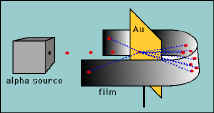 |
|
 |
|
 |
-
John Dalton (1766-1844)
-
Considered to be the father of modern Atomic Theory
-
Combined work of Democritus, Lavoisier, Proust
|
 |
- Charles Coulomb (1736 - 1806)
- Studied the strength of the attractive or repulsive force
between charged objects.
- Lived during the American Revolution.
|
 |
- Antoine Lavoisier (1743 - 1794)
- Proposed Law of Conservation of Matter.
- Also lived during the American Revolution.
|
 |
- Joseph Proust (1754 - 1826)
- Proposed Law of Constant Composition.
- Also lived during the American Revolution.
|
 |
- William Crooks (1852 - 1921)
- Stated that electricity is made up of particles.
- Constructed Crooks Tube, which led to the development of the
Cathode Ray Tube.
- Lived during the American Civil War.
|
 |
- J.J. Thomson (1856 - 1940)
- Discovered the electron.
- Stated that electrons were negatively charged particles that
came from the insides of atoms.
- Proposed the Plum-Pudding
Model of the atom.
- Also lived during the American Civil War.
|
 |
- Ernest Rutherford (1871 - 1937)
- Discovered the nucleus in 1908.
- Proposed Rutherford Model.
- Found that atoms were mostly empty space.
 Performed alpha particle scattering experiments and found
that not all particles went straight through the gold foil. Performed alpha particle scattering experiments and found
that not all particles went straight through the gold foil.- Found the
nucleus to be positively charged.
- Envisioned the atom as having a positively charged nucleus and
electrons scattered around the edge.
- Worked with J.J. Thomson and Geiger, who invented the Geiger
counter around 1910
- Otto Hahn, who later discovered atomic fission, worked under
Rutherford at the Montreal Laboratory in 1905.
|
 |
- Neils Bohr (1885 - 1962)
- Proposed the Planetary Model in 1913 (also called the Bohr
Model).
- Worked in conjunction with Rutherford at Manchester from
1912-1919, during most of these years, World War I was taking
place (1914-1918).
|
 |
- James Chadwick (1891 - 1974)
- Discovered the neutron in 1935, just after America was
recovering from the Great Depression.
- Left University of Manchester just before Neils Bohr started
there (1913).
|
 |
- Robert Millikan (1868 - 1953)
- Measured the electron with his oil drop experiment in 1910, just
after Henry Ford started production his Model T automobile. It
sold for $850.
- Discovered the charge and mass of an electron.
|
 |
- Robert Hofstadter (1915 - 1990)
- Made many discoveries concerning the structure of nuclei.
- Born just after World War I started, died just before the end of
the Cold War and the reuniting of East and West Germany.
|




